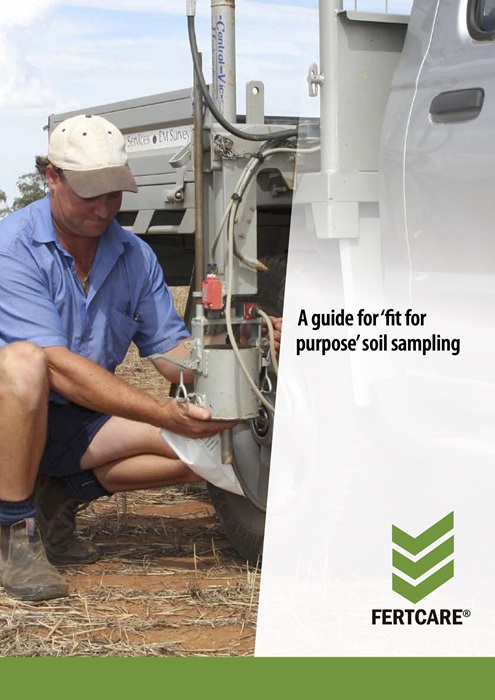Setting up for cropping success
After a couple of good rainfalls in southern Queensland and northern New South Wales, many farmers are taking the opportunity to plan grain, legume or fodder crops.
The success of these crops depends on having a good understanding of the individual nutrient status of each paddock, to then match fertiliser applications to the crop’s needs.
Following the drought and enforced long fallow, the general trends in paddock nutrient status are likely to be:
-
mineralisation of nitrogen after the rain, particularly in bare fallows
-
stable phosphorus and zinc levels
-
a reduction in soil biology, and
-
potential for sulphur leaching beyond the root zone.
However, the only way to confidently plan fertiliser programs to optimise crop yield potential this season is to soil test now on a paddock-by-paddock basis.
Download this article
What’s happening with soil moisture?
Unfortunately, many paddocks do not have a full moisture profile yet. In some cases, this is because not enough rain has fallen to replenish soil profiles that were essentially dry to depth. In other cases, the lack of stubble or ground cover has decreased water infiltration and increased run off.
One of the best ways to determine the depth of moisture in the profile is by observation while extracting segmented soil samples. The testing I have done since the rain has revealed profiles are between 40 and 60 percent full – lower than expected. There is also considerable variation between and within paddocks.
What’s happening with soil nutrients?
Soil nitrogen levels are generally stable during extended dry periods as there are not the conditions to generate either mineralisation or losses. However, the recent rains will have been the catalyst for some much-needed mineralisation. They will also have started the process of stubble break down, potentially immobilising some nitrogen. Remember too that nitrate nitrogen moves with water down the profile, so after very wet conditions, there may be some leaching beyond the crop root zone.
Where crops have been grown despite the dry, nutrient balances will have changed (due to crop removal) and should be assessed with a soil test. Pulse, hay and silage crops can remove significant amounts of nutrients from the system, so soil nitrogen supplies may be low.
At the moment, soil test data is being collected monthly from a site in Dalby, Queensland, as part of a wider case study. See Table 1. In recent test results, the nitrate nitrogen levels increased following rainfall on a fallow paddock and decreased on a cropped paddock.
On the fallow paddock, the total nitrate nitrogen level in the 0-90 cm soil profile increased by 24 kg/ha between January 2020 and February 2020. This site has received 229 mm of rainfall in January and February this year. On an adjacent cropping plot with sorghum stubble from last summer, the tests showed a 9 kg/ha reduction in available nitrogen for the same sampling period, indicating potential nitrogen immobilisation.
This shows the importance of site-specific sampling when planning cropping programs and the potential nitrogen changes that can occur in the soil post rainfall. Relying on older soil test data might not be accurate when reviewing mobile nutrients such as nitrogen.
Table 1: Change in nitrogen levels from January 2020 to February 2020
|
Site |
Situation |
Organic Carbon % 0-10 cm |
Jan 2020 0-90cm Nitrate N (pre-rain) |
Feb 2020 N (post rain) |
Change in Nitrogen |
Jan 2020 Cumulative rainfall (mm) |
Feb 2020 Cumulative rainfall (mm) |
Jan/Feb rainfall total |
|
Dalby (Crop) |
Sorghum stubble from April 2019 |
0.85% |
435 kg N/ha |
426 kg N/ha |
-9 kg N/ha
|
100 |
129 |
229 |
|
Dalby (Bare fallow) |
Long bare fallow-no stubble |
0.85% |
451 kg N/ha |
475 kg N/ha |
+ 24 kg N/ha |
100 |
129 |
229 |
|
Central Downs |
Cultivated fallow from corn 2019 |
1.3% |
402 kg N/ha |
468 kg N/ha |
+ 66 kg N/ha |
82 |
268 |
350 |
Phosphorus levels are likely to be stable, unless a lack of ground cover has led to erosion, as there are high levels of phosphorus in the first few millimetres of topsoil. Where there are budget considerations, take a paddock-by-paddock approach rather than using a flat phosphorus rate across the whole farm.
Don’t forget to check soil sulphur levels this season. Agronomically significant responses to sulphur are known to occur in the northern cropping region in seasons which start with a sudden big wet. This could be as a result of mobile sulphate sulphur leaching or from a lack of fallow sulphur mineralisation during the dry. Either way, responses to applied sulphur are more likely this season.
What’s happening with soil biology?
After drought conditions or long periods of fallow there may be some changes in soil biology. For example, arbuscular mycorrhizal fungi (AMF) populations in the soil are likely to be low after lengthy periods of bare and low-residue fallow. This can be checked with a PreDicta B test.
AMF colonise root systems and help plants to absorb less-mobile nutrients such as zinc and phosphorus. Where AMF populations are low, use Granulock® Z to supply phosphorus and zinc right in the seed zone at planting. This is especially important if planting a dependent crop such as a pulse.
What’s happening with soil constraints?
Drier conditions can temporarily exacerbate subsoil constraints like chloride or salinity. As the soil profile re-wets, these constraints may be diluted or further concentrated. Check the severity of subsoil constraints with soil testing to ensure they don’t become a show-stopper. Be especially careful if planning to grow a sensitive crop, for example, faba beans on a saline soil.
Soil sampling and testing
Soil samples should be taken as close to planting as possible, while still allowing enough time to receive the results, discuss fertiliser budgets, procure fertilisers and plant. Nitrogen mineralisation and nitrification depend on microbial activity, soil temperature and moisture, so the later in the season sampling occurs, the more reliable and stable the test results will be, after all soil processes are complete.
Use segmented sampling to determine the quantity and location of nutrients in the soil. Sample soils from 0-10 cm, 10-30 cm and 30-60 cm. Add a 60-90 cm depth if the intended crop’s roots are likely to be reaching this depth or to check on any potential subsoil constraints.
Your 0-10 cm and 10-30 cm segments should include exchangeable cations, phosphorus (Colwell and BSES), PBI and pH. At each depth, test for chloride, electrical conductivity (salinity), sulphur (MCP) and nitrate and ammonium nitrogen.
For accuracy and reliability, it is important to collect a representative sample to the correct depths and with the right number of cores from the right locations. A good resource for guiding soil sampling practices is the new guide for ‘fit for purpose’ soil sampling from Fertcare.
The Fertcare soil sampling guide is available online. www.fertilizer.org.au

For more information on setting up for cropping success this season, please call me on 0417 896 377 or email bede.omara@incitecpivot.com.au.
References:
®Incitec Pivot Fertilisers and GranAm are registered trademarks of Incitec Pivot Limited. Incitec Pivot Fertilisers is a registered trademark of Incitec Fertilisers Limited ABN 56 103 709 155. Incitec Pivot Fertilisers is a business of Incitec Pivot Limited ABN 42 004 080 264. ®Fertcare is a registered trademark of the Australian Fertilizer Services Association. This is a guide only, which we hope you find useful as a general tool. While Incitec Pivot Fertilisers has taken all reasonable care in the preparation of this guide, it should not be relied on as a substitute for tailored professional advice and Incitec Pivot Fertilisers accepts no liability in connection with this guide.

